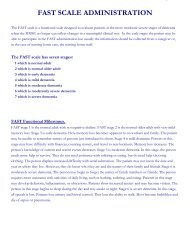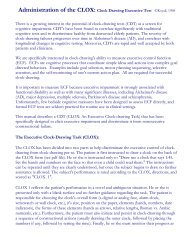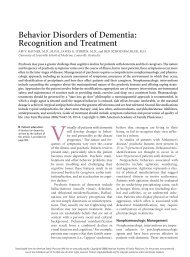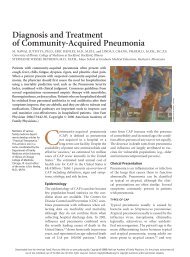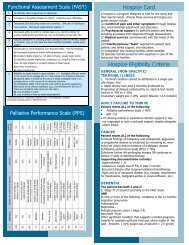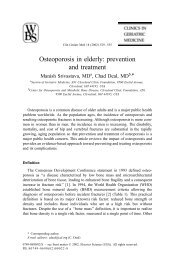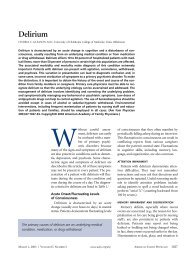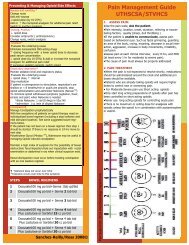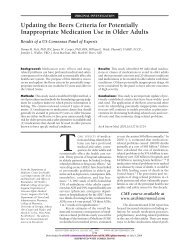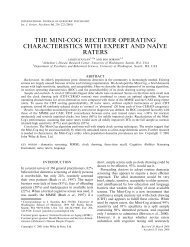Diagnosis and Treatment of Osteoporosis
Diagnosis and Treatment of Osteoporosis
Diagnosis and Treatment of Osteoporosis
You also want an ePaper? Increase the reach of your titles
YUMPU automatically turns print PDFs into web optimized ePapers that Google loves.
<strong>Osteoporosis</strong><br />
Table 3. Evaluation for Suspected Secondary<br />
<strong>Osteoporosis</strong> in Selected Patients<br />
Test<br />
Initial screening tests<br />
Chemistry panel<br />
Alkaline phosphatase<br />
Calcium<br />
Liver or kidney function<br />
Complete blood count<br />
Thyroid-stimulating hormone<br />
Total testosterone (men)<br />
25-hydroxyvitamin D (men)<br />
Possible etiology<br />
High levels in Paget disease,<br />
immobilization<br />
Low levels in vitamin D<br />
deficiency, malabsorption<br />
High levels in<br />
hyperparathyroidism<br />
Liver or kidney disease<br />
Bone marrow malignancy,<br />
malabsorption<br />
Hyperthyroidism<br />
Hypogonadism<br />
Vitamin D deficiency<br />
Additional tests (based on level <strong>of</strong> severity <strong>of</strong><br />
osteoporosis or clinical suspicion <strong>of</strong> underlying disease)<br />
Estradiol (pre- or<br />
perimenopausal women)<br />
Intact parathyroid hormone<br />
Serum protein electrophoresis<br />
25-hydroxyvitamin D (women)<br />
Hypogonadism<br />
Hyperparathyroidism<br />
Multiple myeloma<br />
Vitamin D deficiency<br />
Adapted with permission from Mauck KF, Clarke BL. <strong>Diagnosis</strong>,<br />
screening, prevention, <strong>and</strong> treatment <strong>of</strong> osteoporosis. Mayo Clin<br />
Proc. 2006;81(5):665.<br />
proposed by experts are similar to those for women, as<br />
discussed below.<br />
Indications for <strong>Treatment</strong><br />
Recommendations about which persons with osteoporosis<br />
should receive treatment vary. 2,6 The NOF recommends<br />
treatment <strong>of</strong> postmenopausal women <strong>and</strong> men<br />
with a personal history <strong>of</strong> hip or vertebral fracture,<br />
T-score <strong>of</strong> –2.5 or below, or low bone mass (T-score<br />
between –1 <strong>and</strong> –2.5) <strong>and</strong> a 10-year probability <strong>of</strong> hip<br />
fracture <strong>of</strong> at least 3 percent or any major fracture <strong>of</strong><br />
at least 20 percent. 2 The 10-year probability <strong>of</strong> fracture<br />
is calculated using the WHO fracture risk assessment<br />
tool (http://osteoed.org/tools.php). The WHO recommendations<br />
are less specific, <strong>and</strong> they differ from those<br />
<strong>of</strong> the NOF. The WHO recommends treating persons<br />
with or at risk <strong>of</strong> osteoporosis. 6 Table 4 summarizes the<br />
effectiveness <strong>of</strong> different pharmacologic approaches to<br />
treatment. 15-24 Table 5 summarizes prescribing <strong>and</strong> cost<br />
information for medications approved by the U.S. Food<br />
<strong>and</strong> Drug Administration (FDA). 25<br />
Table 4. Therapy Outcomes for<br />
Postmenopausal Women with <strong>Osteoporosis</strong><br />
Therapy<br />
Hip fracture<br />
Vitamin D (700 to 800 IU<br />
per day) 15<br />
Alendronate (Fosamax) 16<br />
Risedronate (Actonel) 17<br />
Zoledronic acid (Reclast) 18<br />
Hormone therapy 19<br />
Vertebral fracture<br />
Alendronate 16<br />
Ib<strong>and</strong>ronate (Boniva) 20<br />
Risedronate 21<br />
Zoledronic acid 18<br />
Raloxifene (Evista) 22<br />
Calcitonin (Miacalcin) 23<br />
Teriparatide (Forteo) 24<br />
Nonpharmacologic <strong>Treatment</strong><br />
FALL PREVENTION<br />
A multifactorial approach that addresses vision deficits,<br />
balance <strong>and</strong> gait abnormalities, cognitive impairment,<br />
<strong>and</strong> dizziness is the cornerstone <strong>of</strong> fall prevention.<br />
Improving lighting; removing loose rugs; <strong>and</strong> adding<br />
grab bars near bathtubs, toilets, <strong>and</strong> stairways can<br />
enhance safety. 26 Formal home safety evaluations <strong>and</strong><br />
physical therapy treatments are beneficial. 27 Eliminating<br />
medications that can affect alertness <strong>and</strong> balance is critical.<br />
26,27 The use <strong>of</strong> hip protectors is no longer considered<br />
effective. 28,29<br />
CALCIUM<br />
Number needed to treat to<br />
decrease the risk <strong>of</strong> fracture<br />
45 for 2 to 5 years*<br />
91 for 3 years†<br />
77 for 3 years*<br />
91 for 3 years*<br />
385 for 5 years*<br />
37 for 3 years†<br />
20 for 3 years†<br />
15 for 3 years‡<br />
13 for 3 years*<br />
29 for 3 years*<br />
10 for 5 years†<br />
11 for 1.5 years†<br />
NOTE: There were differences in the study populations (age, T-scores,<br />
<strong>and</strong> presence or absence <strong>of</strong> previous vertebral fractures) in these<br />
studies.<br />
*—This study included women with <strong>and</strong> without a previous vertebral<br />
fracture (primary <strong>and</strong> secondary prevention).<br />
†—This study included only women who had a previous vertebral<br />
fracture (secondary prevention).<br />
‡—This study included only women who did not have a previous vertebral<br />
fracture (primary prevention).<br />
Information from references 15 through 24.<br />
The results <strong>of</strong> studies examining the effectiveness <strong>of</strong> calcium<br />
on fracture risk are mixed, but one subgroup from<br />
a recent meta-analysis showed decreased fracture rates<br />
in older women with 80 percent or greater adherence<br />
196 American Family Physician www.aafp.org/afp Volume 79, Number 3 ◆ February 1, 2009



